Growing castor beans from seed can be a bit challenging at first. But once you get the hang of it, you’ll be able to easily grow them every year.
In this post, I am going to give you all the details you need, and show you exactly how to grow castor seeds step-by-step.

Castor bean (Ricinus communis, aka: mole plant) is a fast growing tropical plant, and it’s one of my favorite annuals. I love the red ones especially, they add a wonderful contrast of color and texture to my garden.
I get tons of compliments on them, and everyone asks what they are. I start them from seeds every year, and they grow to be monsters by the end of summer.
Below I am going to show you exactly how to grow castor beans from seed so you can enjoy them in your garden too. I’ll cover everything from start to finish.
This includes which method to use, when to start, step-by-step planting instructions, germination time, and seedling identification.
I’ll also give you tons of seedling care and transplanting tips, show you how to fix common problems, answer your faqs about germinating castor bean seeds, and more!
Toxicity Of Castor Plant Seeds
It’s true that castor plants are beautiful additions to the garden… but be careful with this one. All parts of the plant and the seeds are poisonous if ingested.
You might not want to grow it in your garden if you have pets or kiddos running around. At minimum, you should keep the seeds out of reach of children and pets at all times.
Growing Castor Bean From Seed
Below I am going to give you everything you need to know to successfully grow castor beans from seed. It doesn’t matter which type you have, the steps for planting and germination are the same for all.
Types Of Castor Seeds To Grow
There are several varieties of castor plants, and all of them are easy to grow from seed. The most common ones have green leaves, but I love the red leaf ones the best.
There are also giant varieties that can grow to be upwards of 20′ tall, with huge leaves. And others that have curled leaves that also look amazing in the garden.
What Do The Seeds Look Like?
Castor bean seeds are sometimes referred to as “dog tick seeds”. That’s because they look very similar to wood ticks when they are engorged with blood.
Gross, I know, but it’s the best way to describe them! Haha! Let me see if I can give you a less disgusting description…
Castor seeds are large, oval shaped, and have a pretty spotted pattern on them. One end of the oval has a small nub that sticks out slightly. They are usually brown or reddish in color, but sometimes can look more gray.
Recommended Ricinus Seed Starting Methods
If you live in a warm enough climate, you can sow castor plant seeds directly into the garden. But for most of us, they need to be started indoors.
That’s because they require quite a long growing season to mature to full size. Plus, it can take a long time for the seeds to germinate.
Related Post: 3 Seed Starting Methods That Every Gardener Should Try
When To Plant Castor Bean Seeds
To give them the biggest head start, it’s best to plant them indoors 6-8 weeks before your average last frost date.
That exact date varies depending on where you live. So if you don’t know it, then be sure to look it up. In zone 4b, ours is around May 15th, so I start mine sometime in early April.
Tips For Growing Castor Bean From Seed
Since growing castor bean seeds is different than it is for other plants, there are a few things to consider before sowing them.
Soaking them first will give them a much better chance of germinating. And it’s also important to be sure you use the proper container to make things easier on yourself and the seedlings.
Soaking Castor Bean Seeds
The first step for successfully germinating castor seeds is to soak them in warm water for 24 hours before sowing.
To give them even more of a boost, try soaking them in diluted organic fish emulsion, liquid kelp or compost tea. After soaking the seeds, it will look like one end has popped out – this is normal.
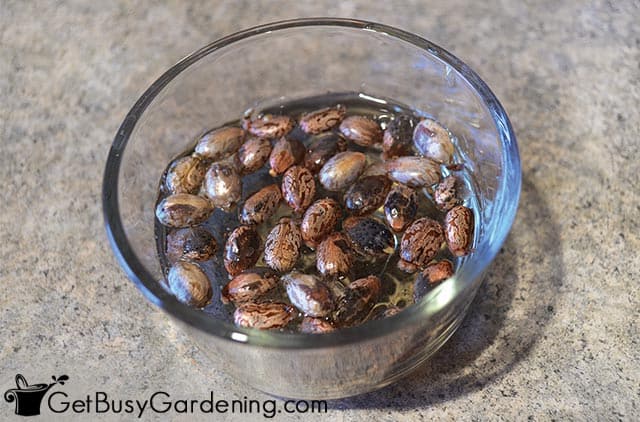
Choosing The Best Containers
It’s a good idea to plant castor oil plant seeds in a deep container, unless you plan to transplant them shortly after they start to grow.
Once they have germinated, the seedlings will grow very quickly. So it only takes a few days for them to outgrow seed starting trays.
You could start them directly in plantable peat pots to make transplanting them to the garden a snap.
If you prefer to use something more sustainable than peat, try coco coir or cow pots instead. Otherwise, plastic seedling pots are perfect (and reusable).
How To Plant Castor Bean Seeds Step-By-Step
You don’t need any special equipment to grow castor bean seeds, but you’ll definitely need a few things. If you do a lot of seed starting, then you’ll already have this stuff on hand…
Supplies Needed
- Plantable pots, reusable plastic pots, or a seeding tray
- Seed starting soil or large peat pellets
- Plastic wrap or a clear bin (if your container doesn’t have a lid)
- Seeds
- Water
- Heat mat (optional, but highly recommended)
Step By Step Instructions
Step 1: Add soil to the seed trays – Fill your container will a high quality seed starting medium. Or you could use pre-moistened large peat pellets instead, and place them into the tray.
Step 2: Drain the water (optional) – You can either drain the water from the seeds, or just pull each one out of the water as you work to plant them. Either way is fine, just make sure they don’t dry out. Also, take care not to damage the little nub that’s sticking out as you work.
Step 3: Plant the seeds – Make a hole in the dirt to the proper depth (they should be planted 1 – 1 1/2″ deep), and drop a seed into the hole. It doesn’t matter which side is up, the seedlings will find their way to the top.
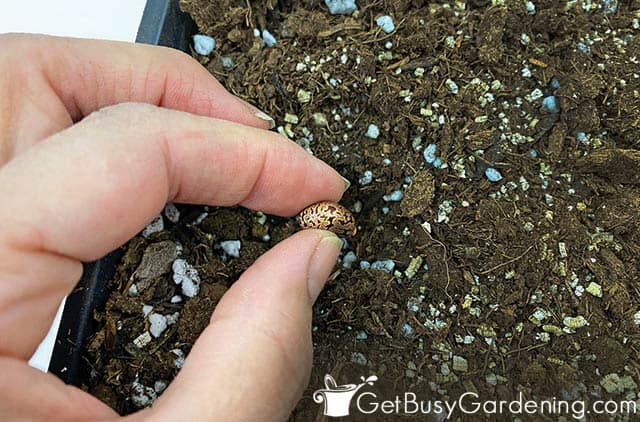
Step 4: Cover the seeds with soil – Bury each one with soil, and then gently press it down. You want to make sure the soil comes in contact with the seeds, but don’t pack it down too tightly over them.
Step 5: Cover the containers – If your container doesn’t have a clear plastic lid, then cover it with plastic wrap. Or you could put them into a large plastic bin with the lid closed to keep the soil moist during germination.
Step 6: Place them in a warm spot – Ideally, you should place them on top of a heat mat, which will speed up germination. Otherwise, put them in the warmest spot you can because they need warm soil to grow.
Step 7: Keep the soil evenly moist – As you wait for the seeds to germinate, be sure to keep an eye on the soil so it doesn’t dry out. It should stay evenly moist, but never allow it to get soggy. Soggy soil can cause the seeds to rot.
Castor Bean Germination Time
It can take a long time to germinate castor seeds, so be patient. The typical germination time is 10-21 days. I’ve had some take as long as a month before finally sprouting, so don’t panic if it takes longer.
The good news is that you can help to speed up germination! The key is keeping the soil nice and warm by adding bottom heat.
So be sure to use a seedling heat mat to help castor bean plant seeds germinate much faster, and lower the risk of rot.
What Do Castor Bean Seedlings Look Like?
As the seedlings emerge from the soil, they look very similar to bean seedlings. The color will vary, depending on the variety you’re growing.
The photo below is red castor bean seedlings emerging from the soil, that’s why they’re pink. Once they start to emerge, they will pop up very quickly.
The first two leaves that grow, called the “seedling leaves”, will be oval shaped. The next leaves to grow after that are called the “true leaves”, and those look like tiny baby castor plant leaves.

Castor Seedling Care Tips
The seedlings can be a bit difficult to care for indoors. So, for the best success, be sure you read through the following care tips before your seeds start germinating. You can also learn more about general seedling care here.
Light
After the seeds finally germinate, the seedlings will grow very fast. So, as soon as you see them popping out of the dirt, add a grow light right away.
Since they grow so fast, a grow light is a must to prevent castor bean seedlings from getting too tall, weak and leggy.
I made my own seed starting grow lights using an inexpensive florescent light fixture and plant grow bulbs, which works great.
Make sure the light hangs an inch or two above the seedlings at all times, and keep it on for 14-16 hours per day. Use an outlet timer to make it easy to control the lights. Check a few times per day, and adjust the height of the light as the seedlings grow taller.
Related Post: A Beginner’s Guide To Grow Lights For Seedlings
Water
Consistent watering is also very important to the health of your castor seedlings. Keep the soil evenly moist, but never wet or soggy. And never allow it to dry out completely.
Give your seedlings a good drink until water starts coming out of the drainage holes, then dump the excess out of the trays. Never leave them sitting in water.
Fertilizer
Once your castor bean plant seedlings grow their first set of true leaves, it’s time to begin fertilizing them.
I prefer (and highly recommend) using an organic fertilizer like fish emulsion or a compost tea solution. (The fish emulsion can get a little stinky indoors, so you may want to use that outside only.)
You could also buy compost tea bags, and brew your own. Whatever kind you decide to use, start with a weak, half dose of liquid fertilizer, and gradually increase it to full strength over time.
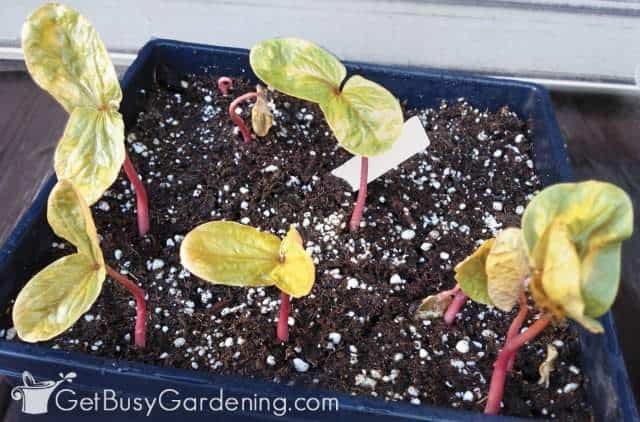
Air Circulation
After your castor seedlings have popped up out of the soil, it’s a good idea to add some airflow. Remove the lids to prevent mildew growth, and run an oscillating fan over them on low to strengthen them up.
You can run the fan for a few hours a day at first, to get them used to it. Then, if you want, you could plug it into the same outlet timer as your lights to make it easy.
Thinning
If you planted more than one seed per hole, then you’ll definitely want to thin out the weakest one. Wait until the seedlings have grown to be a few inches tall, and then remove the smallest/weakest one.
Don’t pull them out though, or it could damage the tender roots of the healthy seedling. Instead, cut it off at the base using a pair of micro-tip snips or bonsai shears.
Repotting
If you planted your castor seeds in small containers or cells, then you’ll need to pot them up once they’re 3-4″ tall to give them plenty of room to grow larger.
Using plantable pots will help ease the transition into the garden, and lower the risk of transplant shock. My favorite types to use are peat pots, ones made out of coco coir, or cow pots.
Otherwise, 4″ plastic nursery pots are the perfect size, and you can reuse them year after year. For soil, either use the same seedling mix you planted the seeds in, or you can use regular potting soil.
Transplanting Castor Bean Seedlings Into Your Garden
After all the hard work and patience it takes to grow castor beans from seed, you don’t want to lose them by planting them outside too early.
So follow the tips below to give them a healthy transition, and learn exactly when to transplant castor seedlings into your garden.
When To Transplant
Castor bean plants hate the cold, so it’s best to wait to plant them, rather than risk doing it too early. If the soil or weather is too cold, the seedlings could die, or their growth could be stunted.
So wait to transplant them into the garden until after all chance of frost is gone, and the soil has warmed up in the spring.
Hardening Off
Before you can plant your castor bean seedlings in your garden, they must to be hardened off to get them ready for life outdoors. Do not skip this step!
Start this delicate transition a few weeks before you plan to transplant them into your garden. Place the seedlings outside in a shady, protected spot for a few hours a day, then bring them back indoors.
Each day, give them a little more time outside, and gradually move them into the sun. After a few weeks, they’ll be toughened up and ready to move to the garden.
Where To Plant Castor Seedlings
Castor bean plants need a full sun location, and lots of heat to grow their best. They will tolerate shade, but the plants will stay small.
Choose a location in your garden where they will be protected from high winds. It’s best to grow them in fertile soil that drains quickly. They like a lot of water, but they don’t like soggy soil.
You certainly could plant them in a large pot, but their growth will be stunted. So a nice, sunny garden location is best.
Related Post: How To Care For Castor Bean Plant (Ricinus communis)

Spacing
Since castor plants grow very large, they need quite a bit of space. Plant the seedlings 36-48″ apart for best results. If they are overcrowded, the plants may not grow very large.
Some varieties grow much bigger than others, so it’s best to research the type you have to give them adequate space.
Seedling Planting Depth
For the best success, plant castor seedlings into your garden at the same depth that they were growing in the container.
Planting them too shallow could expose their delicate roots. While planting too deep could cause them to rot at the base.
Troubleshooting Common Problems
There’s nothing worse than putting all the time and effort into growing castor beans from seed, only to have nothing but problems with them. Especially if you don’t know what’s wrong, or how to fix it!
So here I will list a few of the most common things that may go wrong. You can read more about fixing common seedling problems here.
Castor Seeds Not Germinating
Lack of germination can be caused by a few things: the seeds are old or immature, and therefore not viable, or they could have rotted if the soil was kept too wet. Or maybe they are just really slow, and you need to give them more time.
Leggy Seedlings
This is definitely one of the most common problems for castor seedlings! Since the seedlings grow so fast, they need lots of light, and they need it from the moment they pop out of the dirt. Otherwise, they will quickly grow tall and leggy.
Seedlings Growing Crooked
Lack of light can also cause the seedlings to grow crooked, and reach for the nearest window. So be sure to add a grow light asap (a sunny window is usually not enough).
Seedlings Not Growing
If the seeds germinated, but the seedlings aren’t growing any larger, they may have outgrown their container. If that’s the case, pot them up into a larger one. Otherwise, stunted growth may be caused by either overwatering, or it’s too cold for them (they need to be in a warm location).
FAQs About Growing Castor Seeds
Below I will answer some of the most frequently asked questions about growing castor beans from seed. If you have any questions you can’t find the answer to here, ask them in the comments below.
How many castor seeds per hole?
Since they are so large, it’s best to plant only one castor bean seed per hole. If you’re using old seeds with low viability, I would recommend sowing additional containers, rather than planting more than one per hole.
How deep do you plant castor bean seeds?
Castor seeds should be planted 1″ to 1-1/2″ inches deep.
How long does it take for castor beans to germinate?
Normally it takes 10-21 days for castor seeds to germinate. But it can take up to a month if the conditions aren’t right.
How do you speed up castor bean germination?
The fastest way to speed up germination is to add bottom heat. A heat mat will give you the best results. But at minimum, you should place them in a warm location.
Are castor bean seeds poisonous?
Yes, the are highly toxic. So be sure to keep them away from pets and children.
Growing castor bean seeds isn’t difficult once you learn how. Following the steps in this detailed guide will give you the best success! Just remember, they can be slow, so be sure to have lots of patience.
Up Next: Learn how to collect castor bean seeds from your garden so you can grow them year after year.
If you’re tired of struggling, and want to learn how to grow any plant you want from seed, then enroll in my online Seed Starting Course. It’s a wonderful, fun, self-paced course that will teach you everything you need to know to easily grow your own seedlings. Enroll and get started today!
Or, if you just need a refresher, then my Starting Seeds Indoors eBook is for you! It’s a quick-start guide that will get you planting seeds in no time.
More Info About Growing Seeds
- How To Grow Seeds: The Ultimate Seed Starting Guide
- How To Make Your Own DIY Seed Starting Mix (With Recipe!)
- Tips For Growing Seeds Indoors For Beginners
- How To Test The Viability Of Seeds With An Easy Seed Germination Test
Share your tips for how to grow castor bean plant from seed in the comments section below.
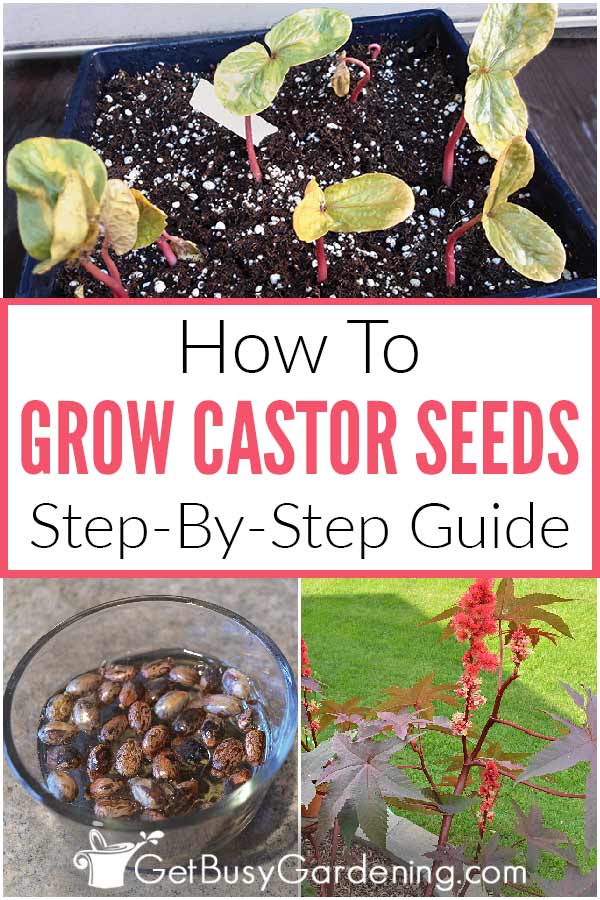
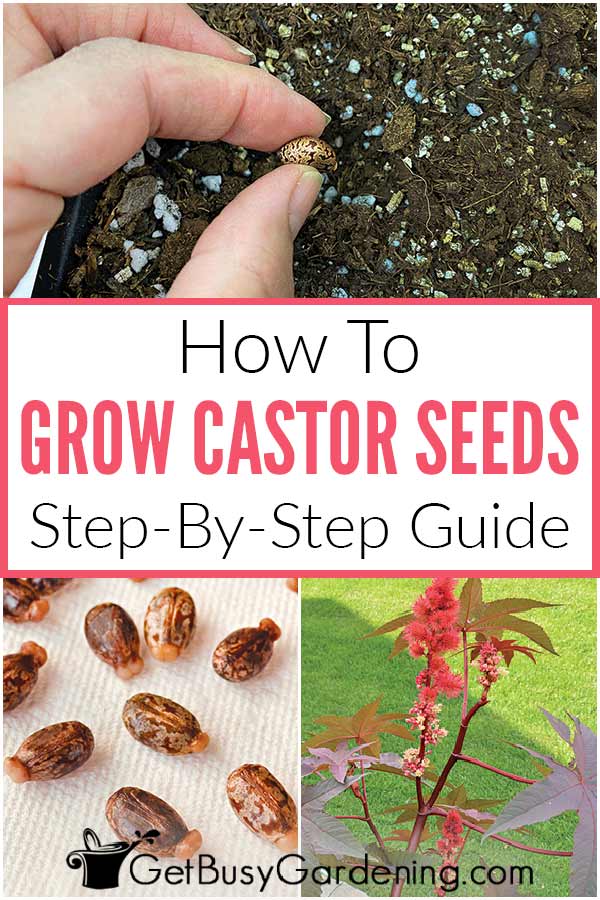
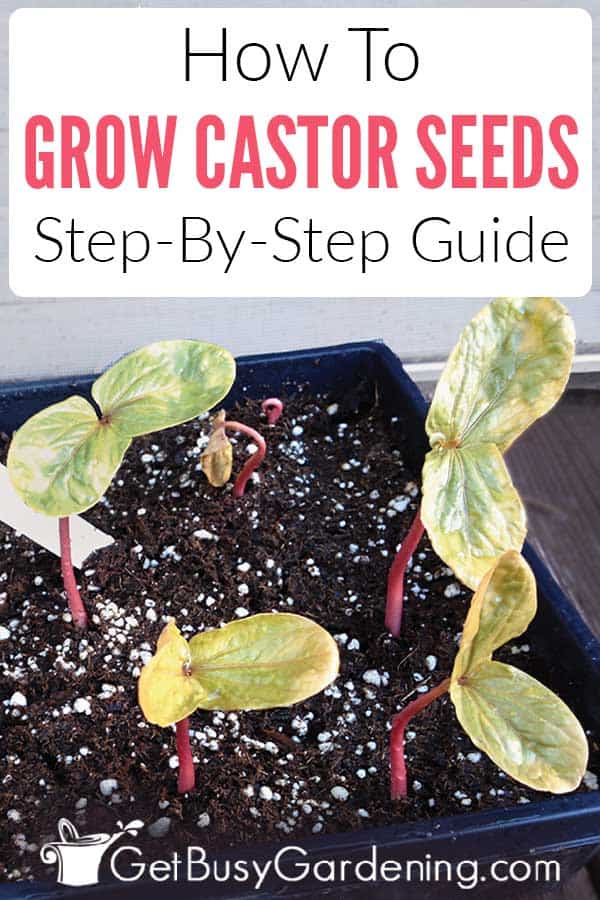

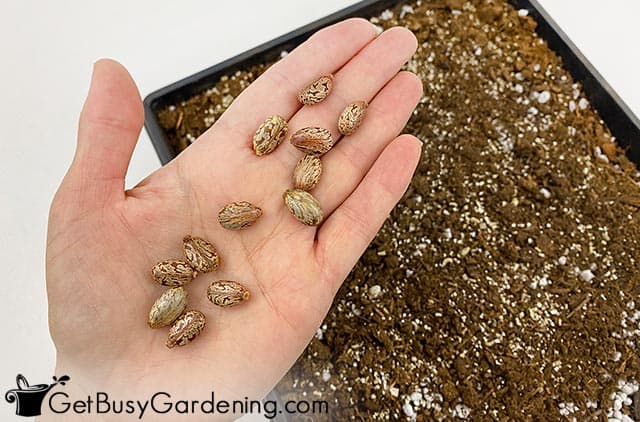
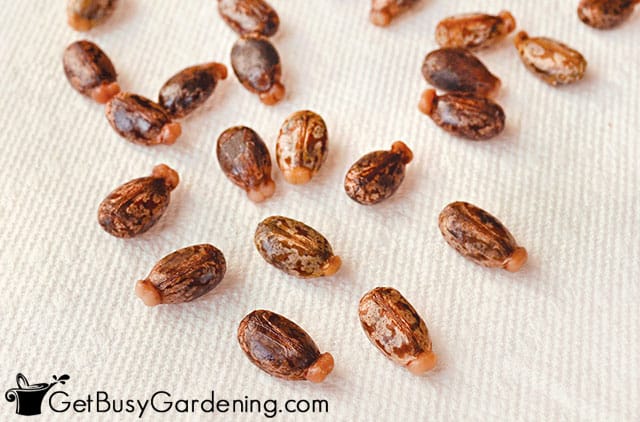
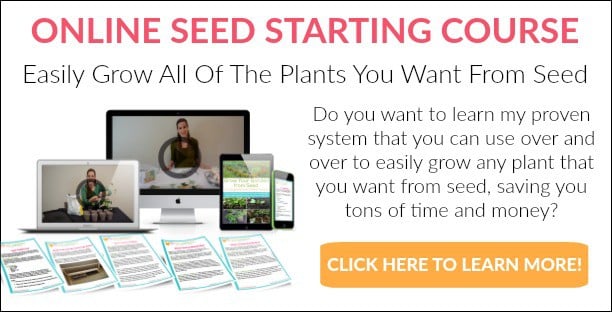

Alick Ngoma says
Can I plant the seed directly in the field and what spacing is recommended between rows and plants in the rows
Amy Andrychowicz says
Yes, that will work fine. Space your castor seeds the same as I recommend in the section above titled “Spacing”.
Ron Thomas says
HOW DO YOU STIMULATE A CASTOR BEAN PLANT TO BLOOM?? LAST YEAR THE PLANTS GREW TO 8 FT. TALL IN MY GARDEN BUT DID NOT BLOOM BEFORE FREEZING.
Amy Andrychowicz says
Castor bean plants needs lots of sun in order to bloom. They also like consistently moist soil, and would benefit from being fed with a fertilizer for blooming plants to help them flower.
Tshewang yeshi says
Can we have nusery raising of castor plant in green house in tropical climate? Is it feasible to do a nursery raising in green house?
Amy Andrychowicz says
As long as they get enough light, then I don’t see why you couldn’t grow castor seeds in a nursery greenhouse.
Silvia Torontow says
Will the plants harm squirrels or chipmunks? We have quite a few in the garden and I currently have a plant in a large pot. I would like to use the seeds to plant in the garden for next year. We live in Ottawa Canada.
Amy Andrychowicz says
Yes, castor plants are highly toxic to animals too, and it could kill them if they eat any part of the plant or the seeds.
Cheryl says
Hello Amy I kept my caster bean out side now when I open the pods the seeds are all dried up are they garbage or do I soak over night I want to start them in the house for planting
Amy Andrychowicz says
It’s normal for the seeds to be dry, so I don’t see any problem there. If I were you, I’d try growing them. It certainly won’t hurt to try. 🙂 By the way, here’s a post that shows you exactly how to collect castor bean seeds.
Herb Roberts says
I grow my own caster beans every year. I first bought a Ricinus caster bean plant and it grow to about 8 feet tall. 2 years ago. Ever since , I save the seeds and plant them in the spring indoors and harden them off as the weather gets warmer.I live in Peterborough Ontario Canada. I get so many comments on my plants its unreal. I find they are pretty easy to start and grow. People say they look like palm trees because of the size of the leaves
Amy Andrychowicz says
Awesome! Castor plants are pretty easy to grow from seed once you get the hang of it – and it sounds like you’ve got it down pat! Great job! I get tons of compliments on them in my garden too, they are gorgeous plants!
DAG DAG says
The viability of CASTOR BEAN seeds is unbelievable! I “found” some leftover seeds on a shelf in the garage that were at least 3 years old, and decided I would try to grow them in an area that would shade some plants I was starting in my shade garden. I used a metal nail file, and lightly scratched each seed before I soak them. Out of 30 seeds, all but 2 sprouted the little numbs. Half of those I planted in peat pots, and half directly into the garden. The potted ones sprouted earlier, and transplanted well, and were about 2-3 weeks ahead of those started in the garden.
Amy Andrychowicz says
Wow, that’s fantastic! Glad to hear that your old castor bean seeds germinated for you! How exciting.
Theresa says
Question: I just found my castor seeds and really want to plant them. Do you think they will still grow nice and big ? Its July and I live in Georgia. They are soaking so I can plant them tomorrow.
Amy Andrychowicz says
It can take a while for castor seeds to germinate. But, they should grow faster in the heat of summer. At this point, I would recommend that you plant the seeds directly into your garden, rather than starting them indoors.
Once the seeds germinate, they are fast growing plants. So, you should still have time for them to mature before it gets too cold for them. I plant mine in early June, and they are usually full grown and gorgeous by the middle-end of August.
Barb sommers says
Great info. I would still like to know if the knib is the root or plant start.
Amy Andrychowicz says
If you mean the nub on the one side of the castor bean seed, that is where the roots will grow from.
Holly Morrical says
I’m growing castor beans for the first time, they are in my garden and about 5” high, maybe too close to each other! Should I pull a few? They are about 3” apart now!!
Amy Andrychowicz says
Yes, I would thin them out if I were you. Once they start to grow larger, the taller castor bean plants will crowd out the smaller ones anyway.
Stephanie Hoffman says
I plant Castor beans each year (Mid March/Zone 6) from seeds from the season before. I have a seed mat placed in a plastic bin and after soaking the beans for 1 day I plant them in a seed starting mix. Each time they sprout anywhere from 5 to 10 days (which is faster than normal). I put them under a grow light when they break thru and transplant in potting soil after they get their true leaves. I put them under the grow light until I can move them outside during the day. Once frost danger has passed I plant them in the ground. If they are in the sun, they will grow well above 10 feet, shader areas, they will stay smaller. Grow with caution if you have animals and completely remove the plant and pods at seasons end. Each and every year I have people comment about how much they love this plant. Starting seeds indoors is great late winter gardening therapy (and how I justify the cost of heating mat and grow lights).
Amy Andrychowicz says
Awesome, thanks for sharing your tips for growing castor plants from seed! I love them too, and always get tons of compliments when I grow them in my garden.
Linda Bailey says
Can the Castor Bean plant be grown as an indoor plant? We have high ceilings, so height won’t be a problem. Also, rather than just starting the seeds inside in the spring, am I able to plant them like in Nov. or Dec. & grow them that long before transferring them outdoors?
Amy Andrychowicz says
Castor beans would not make good houseplants. They don’t grow well in pots, and need TONS of light in order to thrive. Plus some varieties are annual plants, so they only live for about a year. You certainly could start your castor seeds that early, but they grow really fast, and need a lot of light. So, you would definitely need bright grow lights to keep them from growing leggy until you can move them out to your garden.
Julius Akintayo says
really impressed with you guys comments.
actually am planning for castor plantation this year but I need to know how long it takes to grow from germination to maturity for harvesting.
Amy Andrychowicz says
I don’t know the exact number of days, but my castor bean plants take all summer to produce mature seeds (I live in Minnesota). I usually plant castor bean seeds in May, and then harvest the seeds from the mature plants in Sept/October sometime. So, I’d say 4-5 months. They may produce seeds faster in warmer climates though.
Jan says
Has anyone pinched out centre growth of plants to keep them more compact? Last summer my castor beans grew so tall and the beauty of the leaf clusters ended up with leaves far apart from each other. They looked sparse and leggy… if I am able to pinch for my re compact plants will i loose the red spiked flower pods?
Amy Andrychowicz says
I have never tried pinching them to make them bushier. Do you have your castor plants growing in full sun? They will get tall and leggy if they don’t getting enough sunlight. They need a full sun location.
Jan says
Yes I did! I’m going to try the pinching method and will post the results at seasons end… I’m hoping I’ll still get the ‘flower’ spike 🙂
Amy Andrychowicz says
Great! Can’t wait to hear the results of your experiment. I love it! 🙂
Stacy says
Hi, I got a castor bean seedling from a co-worker today. The plants look beautiful, and I am excited to plant it…except that I keep seeing the mention that the whole plant is so poisonous. If I have a dog that has the run of the back yard (where the plant would be located), should I not plant one at all? I keep seeing people mentioning grandkids; my kids are 11 and 13 and would know not to pick up a seed and try to break it open and eat it…just not sure about the dog. Also, we love seeing the squirrels run around…will it kill THEM?
Finally, I read the comments and saw one mention of wearing gloves while working with the seeds. Do you not go near the leaves, etc, of the plant without the gloves either? And do you worry about anything transferring from the gloves to other skin areas? Just not sure how careful you have to be. Thanks for your help!
Amy Andrychowicz says
Yes, all parts of castor bean plants are poisonous if eaten. So, if you’re worried about your dog, then I wouldn’t plant it. Better to be safe than sorry. The only reason I mentioned wearing gloves when collecting the seeds is because the seed pods are spiky, and can be hard to break open with your bare hands. Not because of the poison. I handle them bare-handed all the time. I haven’t seen any dead squirrels laying around, but yes, it could kill them if they decided to eat it. Animals usually have a pretty good sense about these things though I think – we have plenty of healthy rabbits and squirrels running around, and I grow castor beans every year.
Ricin Rodeo says
Over 2 months now and my castor plant, though a baby, looks gorgeous. Btw, I touched a castor plant seed POD before, and it was not spikey. They felt like gentle, thick hairs. But yes, they did win a former world record on most poisonous plant IN THE WORLD! Good luck with your plant.
Amy Andrychowicz says
Great, glad to hear your baby castor plant growing well for you! The seed pods don’t get spiky until they dry out. Then you’ll need gloves to open them up. 🙂
Will says
Stacy and all….
Altho this is a poisen plant there are many others in the plant world….. I have read up some on this topic with the Castor Bean ….The seeds are the most toxic but then they are behind a prickly ball chamber that has to be broken to get to the seeds…I would be afraid of cattle chickens or other non domestic livestock as they will eat anything right.. If you have a big raseling dog I would not plant this castor in his/her area… altho the entire plant would get anyone ill if they chewed a branch tho… Nature has her way to let birds and animals know what is dangerous…. Remember if the temp falls below freezing in your area the plant and seed pods will all freeze off… You can also cut out new seed pods as they develop, leave one for your own replacement seeds, to be stored inside the house all winter… Remember this plant loves the heat and sun.. A big feeder too I feed my castors, Alaska fish amuslion … Bottom line if it is your first attempt then use caution as you seem to be doing…but overall these are justr way cool plants in the cooler temps of the north.as it looks soo tropical….
Geo says
Since about 1985: I have grown green castor beans in Minnesota, 10-12 feet tall. Red and Pink ones in northwest Wisconsin, 5-6 feet tall except in sandy soil without enough fertilizer. I use old manure and kelp tea. Everyone is wowed by them. Best story — one day an old truck pulled into the driveway with southeast Asians, spoke no English. I had seen them going to and from farm fields. They asked, using sign language, if they could pick some leaves for their son’s sprained ankle, as a poultice. Just don’t let anyone eat them, and they’re no problem. This is why humans have big brains. Oh — I sprouted very old seeds this year from plants grown here in Wisc. I thought the plants weren’t even large enough to mature their seeds. ALL of them germinated and are growing nicely in pots. Will transplant in a week or two.
Amy Andrychowicz says
Wow, great story! Love it!
Ricin Rodeo says
So, when should the castor plant start blooming?
Amy Andrychowicz says
They bloom in late summer/early fall.
Ricin Rodeo says
1st year?
Amy Andrychowicz says
Yes.
Ricin Rodeo says
Great. Thanks!
Will says
These castor bean plants are a big hit over here in Zone 6….. Still early tho remember once these seeds pop they start to reach for the sky, be sure they have root room so they can hang on in the wind…
Since these plants do peak late in the season they look great great with mums in front of them also late bloomers…. Castors really do not bloom much but the seed stalk is bright red on some and seem to hold on till frost takes them away..harvest the seed pods tho…
Amy Andrychowicz says
Awesome, thanks for all your added tips!